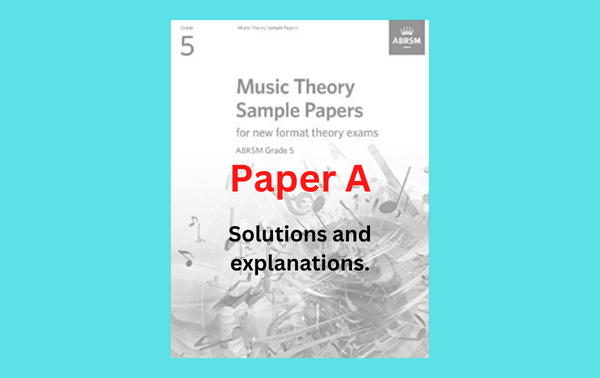Here, you’ll find the answers, and explanations to the questions in Music Theory Sample Papers (2020), ABRSM Grade 5 Paper A.
Table of contents for Music Theory Grade 5 Sample Paper A
Click on the question below to go directly to it explanation.
Section 1: Rhythm
Question 1.1
Question 1.2
Question 1.3
Question 1.4
Question 1.5
Section 2: Pitch
Question 2.1
Question 2.2
Question 2.3
Section 3: Keys and Scales
Question 3.1
Question 3.2
Question 3.3
Question 3.4
Question 3.5
Question 3.6
Question 3.7
Section 4: Intervals
Question 4.1
Question 4.2
Section 5: Chords
Question 5.1
Question 5.2
Question 5.3
Section 6: Terms, Signs and Instruments
Section 1: Rhythm ABRSM Grade 5 Music Theory Exam Sample A
Question 1.1: Time Signature
In this section, students are expected to determine the time signature for a given bar of music.
Question 1.1 (a)
The time signature is 5/8 time:

Question 1.1 (b)
The time signature is 2/4 time:

Question 1.1 (c)
The time signature is 6/8 time:

Question 1.2
This question is on compound vs simple time.
In this question we are given 3/4 time. To convert it to compound time, it’ll be 9/8 time.

Next, we’ll need to convert all simple time to compound time. This means that we’ll need to convert all crotchets to dotted crotchet. To do so, we’ll remove all the triplet signs. For crotchets beats, we’ll put a duplet sign to make it into a dotted crotchet.

Hence, the correct answer is:

Question 1.3
a. In 6/4 time, there are 2 dotted minim beats in a bar.
b. A dotted quaver is equal to 3 semiquavers.
Question 1.4
In 6/16 time, we should group the notes 3 semiquaver beats by 3 semiquaver beats (i.e. group first 3 semiquaver beats together, followed by 4th – 6th semiquaver beats).
Hence, this is the correct answer:

Question 1.5
In the first box, is incorrect. We should have a quaver rest, followed by a semiquaver rest here.
Second box is correct.
Third box is incorrect. The rest should be split into two crotchet rests.
Section 2: Pitch ABRSM Grade 5 Music Theory Exam Sample A
Question 2.1
In this question, you are given a note in tenor clef, and asked to give the name of the note. This note is A.
Question 2.2
This is an enharmonic question. The enharmonic equivalent of B# is D double flat.

Question 2.3
This is a transposition question. In this question, students are asked to transpose a given bar of melody down a perfect 5th.
The key signature for this piece is A Major. When we transpose it down a perfect 5th, it should be D Major (with F# and C#). Since the transposed piece only has F# in its key signature, it is incorrect.
Next, let’s look at how to transpose the other notes down a perfect 5th.
Here’s the answer to the transposition question (question 2.3) of the ABRSM Grade 5 Sample paper A:
| Original | Transposed down a perfect 5th | Compared with given melody |
| Key signature (A Major) — F#, C#, G# | Key signature (D Major) — F#, C# | ✗ |
| C | F | ✓ |
| E | A | ✓ |
| F | B flat | ✗ |
| D# | G# | ✗ |
Question 2.4
For the pieces of melody given:
B is one octave higher than A and C.
A and C are at the same pitch.
Hence, these are the answers:
(a) False
(b) False
(c) True
Section 3: Keys and Scales ABRSM – Grade 5 Music Theory Exam Sample A
Question 3.1
Here’s the correctly written key signature of G flat Major:

Question 3.2
Here’s the correctly written key signature of D# minor:

Question 3.3
In this section, we are asked to determine the key of a piece of melody. Here’s the answers:
(a) G Minor
(b) D flat major
(c) C minor
Question 3.4
In this question, students are asked what are the missing notes at X, and Y.
This is a question on descending scale of A Major. Here’s the answers:
X: F#
Y: B
Question 3.5
In this question, students are asked to give a clef (treble, bass, alto or tenor clef), so that the resulting scale is in a minor key.
Here’s the answer:
(a) treble clef
(b) tenor clef
(c) bass clef
Question 3.6
In this question, we are asked whether the chromatic scale is correctly written. Here’s the answers:
(a) True
(b) False
Question 3.7
This questions tests students on the technical names of notes. Here’s the answers:
(a) True
(b) False
(c) True
Section 4: Intervals – ABRSM Grade 5 Music Theory Exam Sample A
Question 4.1
(a) diminished 11th
(b) perfect 5th
(c) compound diminished 7th
Question 4.2
(a) diminished
(b) major
(c) augmented
Question 4.3


Section 5: Chords – ABRSM Grade 5 Music Theory Exam Sample A
Question 5.1
IV, I, II, I , V
Question 5.2
(a) plagal
(b) imperfect
Question 5.3
IVc
Vc
Ib
Section 6: Terms and Signs – ABRSM Grade 5 Music Theory Exam Sample A
Section 6.1
This question is on terms and signs.
Here’s the answers:
vite
quick
traurig
sad
perdendosi
dying away
Section 6.2
This question is on ornaments.
(a) lower mordent
(b) acciaccatura
Section 6.3
This section consists of true/ false questions on instruments.
(a) False
(b) False
(c) True
(d) False
(e) True
Section 7: Music in Context – ABRSM Grade 5 Music Theory Exam Sample A
7.1 Only A is correctly written 2 octaves lower
7.2
(a) True
(b) False
(c) False
(d) False
(e) False
7.3 flute
7.4 3
7.5
(a) bar 3
(b) bar 7
More on Grade 5 ABRSM Online Music Theory Exam
- About the exam
- ABRSM Grade 5 Online Practice Paper – Video explanation
- ABRSM Grade 5 Music Theory Sample Papers Worked Solutions (2020)
- ABRSM Grade 5 Music Theory Sample Papers Worked Solutions (2021)
